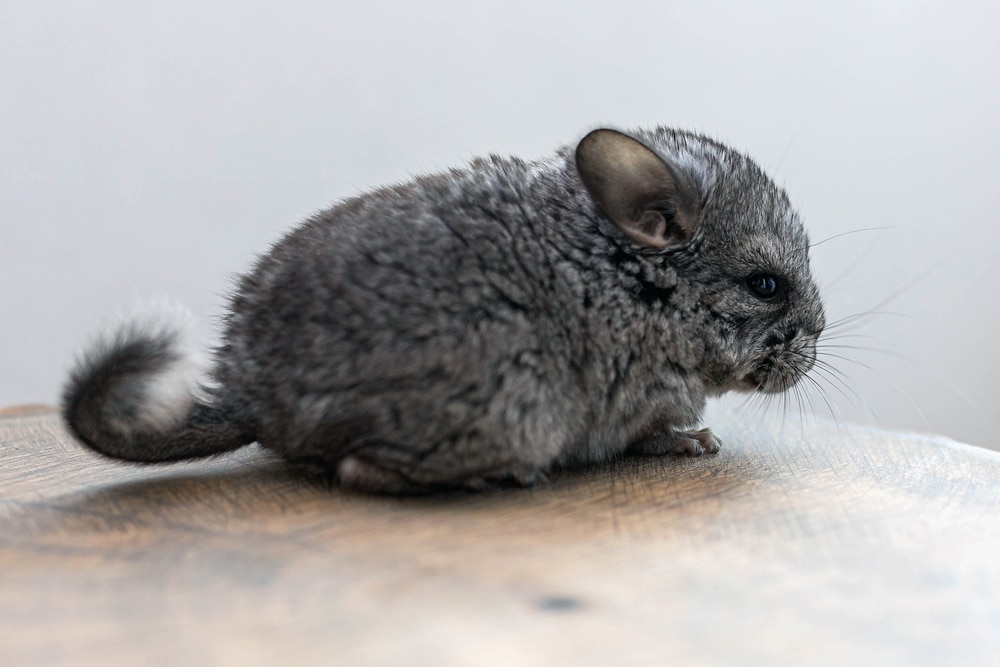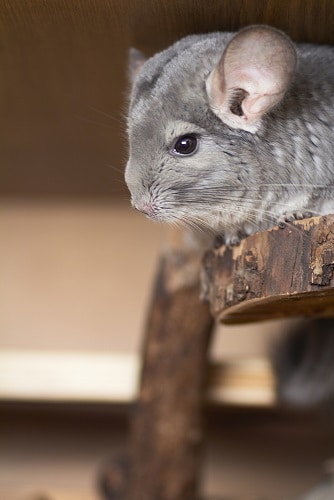
Taking care of a pet chinchilla is not like taking care of a cat or a dog; you have to make sure that your little being never gets wet because a chinchilla’s fur is so soft and dense that water stays there and barely escapes from the fur.
If your chinchilla stays wet for a while, there is a certainty that the fur may grow mold and cause serious fungal infections like ringworm.
Though a few drops of water won’t harm your chinchilla, you should prevent its fur from getting soaked. A chinchilla may occasionally need to take a bath in water due to an emergency.
Typically, if your chinchilla is exposed to household chemicals, urine, or other potentially hazardous substances, it is necessary to rinse them for deep cleaning.
Moldy Wet Chinchilla
What Happens If Your Chinchilla Gets Wet?
Never let a chinchilla’s body get wet, not even for a little while. Water and chinchillas make for a poor combination. It’s easy to distinguish between chinchillas and rodents because of their extraordinarily thick fur.
If your chinchilla’s fur gets damp, it can become tightly packed together, forming a large unpleasant mass.
Additionally, the thick fur may dry very slowly, making it difficult for chinchillas to stay warm. Water can also cause fungal diseases in small animals because of the extreme moisture.
What To Do If Your Chinchilla Gets Wet?
If your chinchilla somehow gets wet, don’t panic and try to dry its body with a towel. Or you can also use a blow dryer. Make sure you put the dryer on the lowest level and two feet away. As chinchillas have very soft fur, using a hair dryer increases the risk of burning their skin.
If you feel like your chinchilla is developing a reaction to being wet and exposed to water, you should go to your local veterinarian immediately. We’ll discuss what you should do if your chinchilla ever gets wet.
- Maintain Your Chinchilla
If you’re scared about cleaning your chinchilla with water, it’s still possible to keep your little being clean, healthy, and maintained. Remember that chinchillas are also pretty passionate and avid self-groomers, just like the feline family.
- Dust Bath
If your chinchilla gets wet, don’t wait and take action. Ideally, you can give your chinchilla a dust bath to help soak up excess moisture. You can easily get chinchilla dust from pet stores, so all you have to do is put it in a bowl and keep it nearby.
Allow your pet chinchilla to roll around in the dust to absorb extra moisture, which is good for its coat health and makes it shine. Bathing your chinchilla in the dust is the best approach to keep it clean and maintained.
If bathing your chinchilla in dust does not work and your little pet is exposed to serious infections, you should contact your veterinarian immediately.
- Manage Its Hygiene
Washing your chinchilla with water is a major mistake that many pet parents make when they first bring home a cuddly chinchilla.
Unlike various furry animals, chinchillas’ coats don’t have waterproofing oil, which causes the fur to absorb more moisture. Chinchillas could struggle to dry up and experience health problems like pneumonia, fungus infections, or mold growth.
Chinchillas clean up after themselves. They regularly bathe in fine sand that draws moisture from the fur to clean and degrease their hair. This keeps the hair apart and prevents knots from forming.
- Brush Your Chinchilla’s Hair
It is advised to brush your chinchilla daily with specialized tools, such as Ferplast’s brushes and combs for mice, to keep the hair lustrous and silky. To eliminate debris and dead hair, combs or carding brushes work well.
The short, soft-bristled brushes work gently on the coat without making contact with the skin. On the other hand, a double-bristle brush smoothes and shines the coat while removing knots from one side of the coat.
- Avoid Excessive Cuddling
Although their furry coat makes chinchillas look very cuddly, experts recommend pet parents not do so for long periods. In actuality, its hair is exceptionally fragile because of its capillary nature. Too much cuddling could result in excessive hair loss.
How Often Should You Bath Your Chinchilla with Dust?
It would help if you bathed your chinchilla in dust four times weekly in hot and humid weather. In contrast, you can bathe them in cold and dry weather twice a week.
Beyond the hygienic benefits mentioned above, dust baths are a fantastic method for pet parents to develop the vital animal-human link while also providing a great source of mental and physical stimulation for your cute little pets.
You should always consult a trustworthy veterinarian if your chinchilla exhibits any signs of skin or coat problems because each pet is different.
Facts About Your Chinchilla’s Fur
If your chinchilla is frightened or under extreme stress, it loses fur, much of which affects the tail.
It uses it as a defense mechanism against its predators in the wild, and it also applies to pet chinchillas. You can look after your chinchilla and take care of its fur to ensure it is soft, shiny, and tidy.
Considerations For Petting A Chinchilla
If you have a pet chinchilla, we recommend you take measures for its health as it is very sensitive to temperature. Whether you plan on keeping it caged or not, you must take care of its surroundings and environment so they don’t feel stressed.
Keep them away from water or other liquids, so they don’t get wet. Give your pet chinchilla appropriate exercise equipment to help it build muscles. And if you keep yours caged, let it roam around for a while.
Conclusion
Chinchillas as a pet are different from other pets, and if you own one, you must take care of them and take necessary actions whenever needed.
Keep your chinchilla away from water and getting soaked, as its body is not built for it. But if it does get wet somehow, you must dry it immediately or consult your nearest veterinarian.

